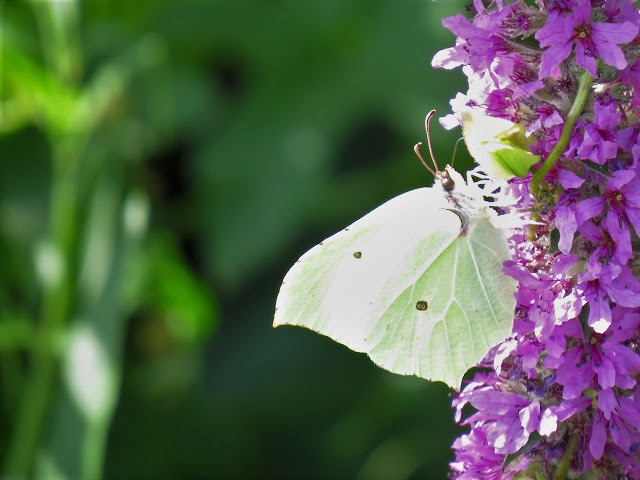23rd July 2022 - a group of nine ANW members visited Wicken Fen Nature Reserve, owned by the National Trust. After a brief introduction from the staff, we followed the 'board walk' around part of 'old' Wicken Fen, which is one of the last remaining unimproved and undrained fens, and so contains a good diversity of 'typical fenland' flora and fauna.
Sightings and news for the Naturewatch group of Great and Little Abington in Cambridgeshire, UK. See below for more details and information on how to join.
Sunday, 24 July 2022
ANW Visit to Wicken Fen
Thursday, 21 July 2022
Common Blue butterfly
19th July 2022 - Polly and Andy M spotted this Common Blue butterfly on the Marjoram whilst recently doing their Big Butterfly Count in their garden.
Holly Blue butterfly finding a drink
19th July 2022 - Perhaps not the most savoury of sources of moisture, but in this heat a drink can be hard to come by - Andy M spotted this second brood Holly Blue butterfly taking refreshment from this fresh Hedgehog dropping in the garden one morning.
Tuesday, 19 July 2022
Big Butterfly Count - 15th July to 7th August
15th July to 7th August 2022 - is the period of the Big Butterfly Count, run by Butterfly Conservation nationally each year. The count involves simply noting how many of each butterfly species seen at your preferred location during just 15 minutes anytime between 15th July and 7th August.
Further details, including this useful ID chart, and submission of your results on their website:
https://bigbutterflycount.
If you take part, and do your Big Butterfly Count in the Abingtons, please also email your results to Polly M (insect recorder for Abington NatureWatch) at polly.merryweather61@gmail.
Monday, 18 July 2022
Purple Hairstreak
18th July 2022 - Polly M was very happy to spot a Purple Hairstreak butterfly flying low just above the lawn this morning. Whilst quite commonly found around oak trees, this butterfly is normally only glimpsed flying high in the canopy, and so seeing it close up was quite a treat, making identification a good deal easier.
Hummingbird Hawkmoth
12th July 2022 - Derek T had a visit from a Hummingbird Hawkmoth, rapidly flitting between the flowers of a Buddleia in his garden.
Emperor Dragonfly
17th July 2022 - Andy M spotted a large dragonfly patrolling around his garden, which helpfully came to rest in a tree allowing a photo and more certain identification as an Emperor Dragonfly.
Key features being the size (large!), blue/green eyes, a mostly green thorax as well as green on the first part of the abdomen, then a mostly blue and black abdomen, and amber front edges to the wings.
Wednesday, 13 July 2022
Silver-washed Fritillary butterfly
13th July 2022 - Polly and Andy M were lucky enough to spot a Silver-washed Fritillary butterfly in their garden today - in fact it even came into the kitchen briefly to pose for a photo.
Tuesday, 12 July 2022
Many Young Swallows
10th July 2022 - while cycling around the Land Settlements, Andy M was very happy to spot 45-50 Swallow, mostly young ones, lined up along the wires, busily preening in the lovely sunny weather. Clearly the first broods this year have been rather successful.
Young Blue Tit
Butterflies galore!
8th July 2022 - Warm, sunny weather and virtually no wind seemed to provide the perfect conditions for butterflies in Andy and Polly M's garden at the weekend. Overall they spotted a whopping fourteen different species, several appearing for the first time this year in the garden: Brimstone, Comma, Common Blue, Gatekeeper, Large Skipper, Small Skipper, Large White, Small White, Marbled White, Meadow Brown, Peacock, Red Admiral, Ringlet and Small Tortoiseshell.
The Aims of Abington Naturewatch
At their meeting on 9 April 2005 the members approved this revised version of the aims of Abington Naturewatch:
- To monitor and record the wildlife (fauna & flora) within the borders of the Abingtons;
- To encourage protection of our wildlife, maintain its quality and foster its diversity;
- To promote awareness of the richness, potential and problems of the natural environment of the Abingtons;
- To cooperate in improving access to the local natural environment for the benefit of all Abington villagers.
The organisation is informal and communication is by email if possible; members are notified of events from time to time. Contact details are maintained by a small "project team". There is currently no membership fee as costs are covered by voluntary contributions at events.
Members are encouraged to report notable sightings of flora and fauna within the Abingtons to the appropriate sector coordinator and an illustrated record is published annually.
A map of the area covered, with some features noted, is available here: http://maps.google.co.uk/maps/ms?ie=UTF8&hl=en&msa=0&msid=213774935674882866424.00000111dca2be9f06ab8&z=13>
For more information or to join, please contact David Farrant on (01223) 892871.
Contributions to our records should be sent to sector contacts or either of the above. Photographs may also be submitted to Andy Merryweather (amerryweather61@gmail.com)






























































